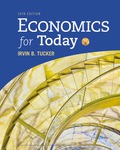
Economics For Today
10th Edition
ISBN: 9781337670654
Author: Tucker
Publisher: Cengage
expand_more
expand_more
format_list_bulleted
Question
Chapter 14, Problem 4SQ
To determine
The command and control regulation.
Expert Solution & Answer
Want to see the full answer?
Check out a sample textbook solution
Students have asked these similar questions
Answer
M” method
Given the following model, solve by the method of “M”. (see image)
As indicated in the attached image, U.S. earnings for high- and low-skill workers as measured by educational attainment began diverging in the 1980s. The remaining questions in this problem set use the model for the labor market developed in class to walk through potential explanations for this trend.
1. Assume that there are just two types of workers, low- and high-skill. As a result, there are two labor markets: supply and demand for low-skill workers and supply and demand for high-skill workers. Using two carefully drawn labor-market figures, show that an increase in the demand for high skill workers can explain an increase in the relative wage of high-skill workers.
2. Using the same assumptions as in the previous question, use two carefully drawn labor-market figures to show that an increase in the supply of low-skill workers can explain an increase in the relative wage of high-skill workers.
Chapter 14 Solutions
Economics For Today
Ch. 14.2 - Prob. 1.1GECh. 14.2 - Prob. 1.2GECh. 14.2 - Prob. 1.3GECh. 14.2 - Prob. 2.1GECh. 14.2 - Prob. 2.2GECh. 14.2 - Prob. 2.3GECh. 14.2 - Prob. 2.4GECh. 14 - Prob. 1SQPCh. 14 - Prob. 2SQPCh. 14 - Prob. 3SQP
Ch. 14 - Prob. 4SQPCh. 14 - Prob. 5SQPCh. 14 - Prob. 6SQPCh. 14 - Prob. 7SQPCh. 14 - Prob. 8SQPCh. 14 - Prob. 9SQPCh. 14 - Prob. 10SQPCh. 14 - Prob. 11SQPCh. 14 - Prob. 12SQPCh. 14 - Prob. 13SQPCh. 14 - Prob. 14SQPCh. 14 - Prob. 15SQPCh. 14 - Prob. 16SQPCh. 14 - Prob. 1SQCh. 14 - Prob. 2SQCh. 14 - From an economic viewpoint, the optimal amount of...Ch. 14 - Prob. 4SQCh. 14 - Prob. 5SQCh. 14 - Prob. 6SQCh. 14 - Prob. 7SQCh. 14 - Prob. 8SQCh. 14 - Prob. 9SQCh. 14 - Prob. 10SQCh. 14 - Prob. 11SQCh. 14 - Prob. 12SQCh. 14 - Prob. 13SQCh. 14 - Prob. 14SQCh. 14 - Prob. 15SQCh. 14 - Prob. 16SQCh. 14 - Prob. 17SQCh. 14 - Prob. 18SQCh. 14 - Prob. 19SQCh. 14 - Prob. 20SQ
Knowledge Booster
Similar questions
- Published in 1980, the book Free to Choose discusses how economists Milton Friedman and Rose Friedman proposed a one-sided view of the benefits of a voucher system. However, there are other economists who disagree about the potential effects of a voucher system.arrow_forwardThe following diagram illustrates the demand and marginal revenue curves facing a monopoly in an industry with no economies or diseconomies of scale. In the short and long run, MC = ATC. a. Calculate the values of profit, consumer surplus, and deadweight loss, and illustrate these on the graph. b. Repeat the calculations in part a, but now assume the monopoly is able to practice perfect price discrimination.arrow_forwardThe projects under the 'Build, Build, Build' program: how these projects improve connectivity and ease of doing business in the Philippines?arrow_forward
- Critically analyse the five (5) characteristics of Ubuntu and provide examples of how they apply to the National Health Insurance (NHI) in South Africa.arrow_forwardCritically analyse the five (5) characteristics of Ubuntu and provide examples of how they apply to the National Health Insurance (NHI) in South Africa.arrow_forwardOutline the nine (9) consumer rights as specified in the Consumer Rights Act in South Africa.arrow_forward
arrow_back_ios
SEE MORE QUESTIONS
arrow_forward_ios
Recommended textbooks for you
 Economics (MindTap Course List)EconomicsISBN:9781337617383Author:Roger A. ArnoldPublisher:Cengage Learning
Economics (MindTap Course List)EconomicsISBN:9781337617383Author:Roger A. ArnoldPublisher:Cengage Learning


 Essentials of Economics (MindTap Course List)EconomicsISBN:9781337091992Author:N. Gregory MankiwPublisher:Cengage Learning
Essentials of Economics (MindTap Course List)EconomicsISBN:9781337091992Author:N. Gregory MankiwPublisher:Cengage Learning

Economics (MindTap Course List)
Economics
ISBN:9781337617383
Author:Roger A. Arnold
Publisher:Cengage Learning





Essentials of Economics (MindTap Course List)
Economics
ISBN:9781337091992
Author:N. Gregory Mankiw
Publisher:Cengage Learning